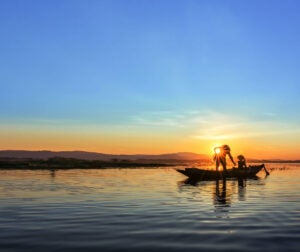
At Capitol Hill Ocean Week, EDF discussed the intersections between ocean and climate – and the potential for change.
By Lucy Vogt, EDF Seafood Policy Intern
Last month, Capitol Hill Ocean Week (CHOW) welcomed environmental businesses, leaders, and shakers — and one brand-new intern.
CHOW investigated the intersection between the ocean and the climate by facilitating conversations about ocean opportunities. Even though the ocean covers more than 70% of the earth, produces 50% of the oxygen we need and absorbs 25% of the carbon emissions we produce, it is often perceived solely as a victim of climate change. But this massive ecosystem holds a wealth of potential climate solutions, and CHOW conversations ranged from offshore wind to maritime shipping to partnerships with coastal communities.
And in my first week as a Seafood Policy intern at Environmental Defense Fund, I got to attend CHOW with EDF’s US Fisheries and Oceans team. It was a window into the powerful possibilities of the sea and the potential it holds to fight climate change.
Environmental Defense Fund is leaning into those possibilities, too, by developing projects around resilient fisheries and communities, blue carbon and offshore aquaculture. At CHOW, EDF experts helped moderate and contribute to conversations about each.
Resilient Fisheries and Communities
United States fishermen and fishing communities are increasingly threatened by climate change. I learned that EDF seeks to foster partnerships between fishers, scientists and policymakers, working to change the trajectory from vulnerability to resiliency.
On a panel discussing climate resilience for fisheries and fishing communities, Dr. Julia Mason, a researcher on EDF’s Ocean Science team, highlighted the importance of unity in the face of climate change, introducing a multi-institution case study that took place across 18 regional fisheries to uncover activities that promote resiliency. The collaborative research project resulted in a holistic planning tool to guide resilience-focused fishery management.
Blue Carbon
The ocean has captured and stored 30% of human emissions since the industrial revolution began in 1860 by absorbing it through growing kelp, marsh grasses, and mangroves. These ecosystem benefits are referred to as blue carbon.
Restoring and rebuilding blue carbon processes is one of the many solutions that can reduce the carbon in our atmosphere while also uplifting marine ecosystems and local economies. At CHOW, possible solutions included reducing marine emissions by using more sustainable shipping fuels, bolstering natural carbon sequestration, and developing new technologies to monitor carbon levels.
As exciting ocean solutions emerge, EDF and other CHOW participants are leading by example as facilitators of collaboration between science, policy and industry. Although the natural processes that establish blue carbon are ancient, understanding how human activities both disrupt and aid blue carbon is relatively new. To better understand the potential for blue carbon, EDF convened over 60 researchers and marine policy experts to draft a report on the magnitude of blue carbon as a natural climate solution. Three new reports now guide initiatives to generate blue carbon, leading to a more sustainable future.
Offshore Aquaculture
Even under the best management scenarios with US fisheries at peak health, wild seafood cannot meet the increasing demand. Already the US imports up to 90% of its seafood, half of which is farmed. Offshore aquaculture in the US would provide an opportunity to grow more seafood here and create a model for sustainable ocean farming practices. Charting pathways to climate-resilient food systems are integral to the ocean’s role in fostering climate solutions.
While there were no scheduled events on US offshore aquaculture at CHOW, EDF’s Ruth Driscoll-Lovejoy is cautiously optimistic about offshore aquaculture’s potential as well as the continued work with EDF’s partners in the Coalition for Sustainable Aquaculture, an alliance of chefs, nonprofits, industry leaders and representative groups seeking to grow more seafood here in the US — and do it right.
What Comes Next
While Ocean Month has ended, the work to center the ocean as a core climate solution is just beginning. The ocean provides a bounty of opportunities to fight climate change while also uplifting US economies and helping us strive toward a more sustainable future.
CHOW concluded with an appreciation for the ocean and the participation of stakeholders across sectors. More importantly, CHOW asked every attendee how they would center the ocean in their climate work.
As someone who is just breaking into the ocean space, CHOW opened my eyes to the magnitude of ocean-based climate solutions and filled me with the hope that if we can recognize the ocean’s inherent capabilities, rely on valued community partnerships and trust scientific research, we could truly enact change.
